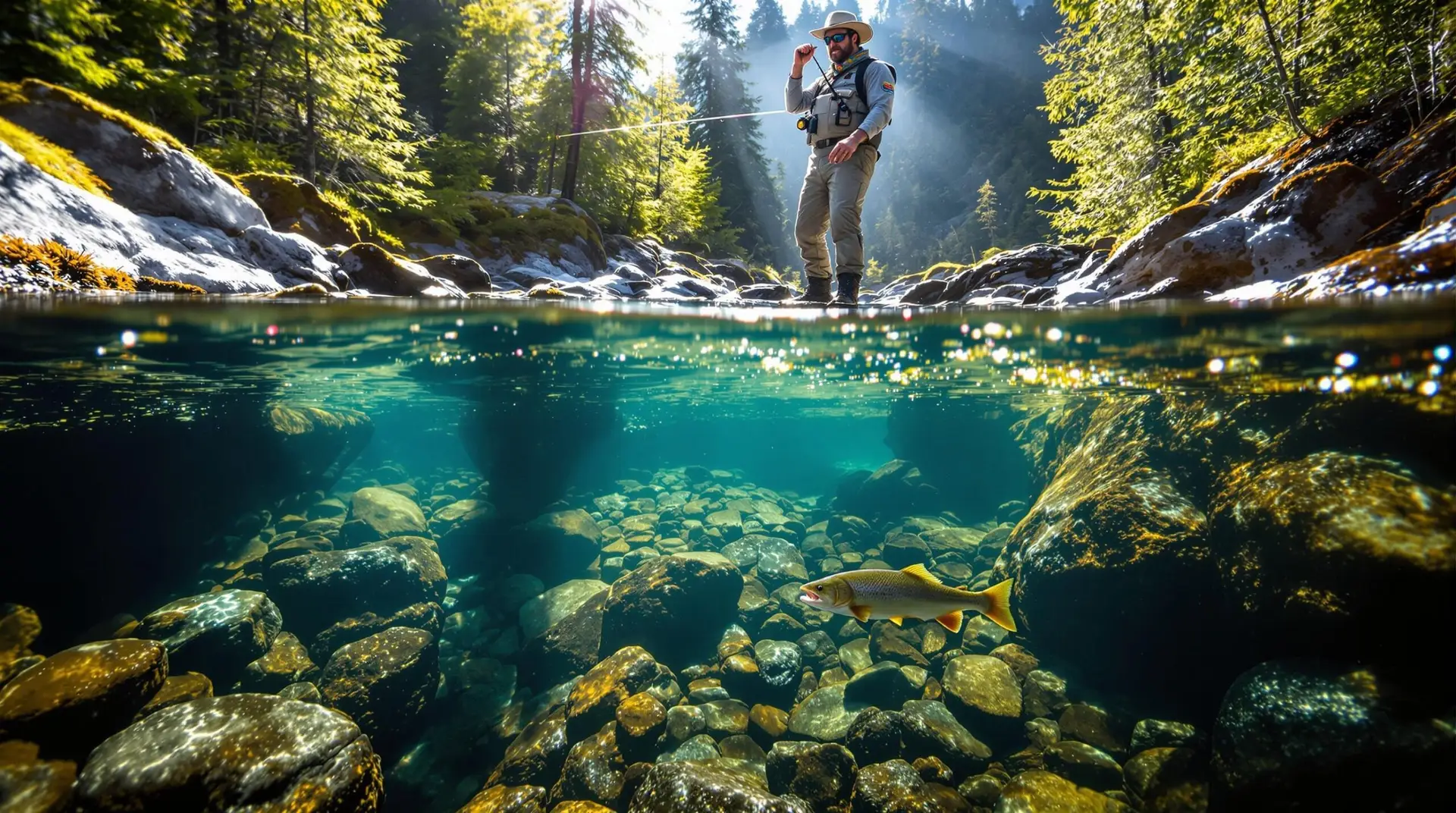Advantages of Using Multiple Nymph Rigs
Fishing with multiple nymph rigs packs a punch for seasoned fly fishers, mainly through added flexibility and the knack for tackling different water depths with ease.
More Flexibility On The Water
Rocking a multiple nymph rig pumps up the fishing adventure by letting you switch things up on the go. It’s all about throwing different bugs at those sneaky trout, blending right into the water scene. You could have a blast using various nymph patterns, covering an awesome spread of bug species, sizes, shapes, and hues like caddis, mayflies, stoneflies, midges, and even terrestrials—those are crowd favorites (The Fly Crate).
Tag-teaming with two nymphs on a single rig, like the wicked tandem nymph rig, can really up your trout-game. The two nymphs have each other’s back, making sure they land where the fish want them to and getting that snag-free drift just right (Troutbitten). And hey, you might just stumble upon some nifty fishing hacks to boot—amplifying the thrill and discovery factor.
Reaching Those Trout Hangouts
One big win with using multiple nymph rigs is nailing those different water depths all at once. By messing around with the weight of your flies, you can get them cruising at varied levels in the water. This means you cover more ground, especially since trout love chilling out at different depths in the same water spot.
Take the drop-shot rig, for example. It’s magic in letting you station flies at strategic heights, hitting all the right feeding zones (Troutbitten). You’re not only upping your fishing smarts but also boosting the odds of serving up the trout’s meal of the day.
| Fly Types | Why Include Them |
|---|---|
| Caddis | Mirrors a mix of bug species |
| Mayflies | Shows off a range of bug sizes and looks |
| Stoneflies | Pulls off that natural aquatic vibe |
| Midges | Copycats that bug color palette |
| Terrestrials | Dangles them at assorted depths |
By employing multiple nymph setups, anglers bring their A-game in targeting trout at varying depths and serving a smorgasbord of bug patterns. This approach shines in any fishing spot, making it a go-to tactic for those fired-up about perfecting their technical nymph fishing skills. For more funky setups, don’t miss our guide on understanding different rig setups.
Challenges of Fishing Multiple Nymph Rigs
When it comes to the nitty-gritty of advanced Euro nymphing, using multiple nymph rigs can give a bunch of perks—but it ain’t all smooth sailing. Knowing the hiccups and fixing ’em can boost your chances of reeling in the big ones.
Potential Drag Issues
Juggling multiple flies in one rig can whip up a mess of drag. Nymphs at the bottom move at their own pace, different from those chilling near the surface. Nailing that perfect drift for ’em all at once is tricky biz. As Tenkara Talk points out, this hiccup can mess with presentation, making the flies look suspicious to our fishy friends.
| Fly Position | Drag Level | Water Flow Rate |
|---|---|---|
| Near Surface | High | Fast |
| Near Bottom | Low | Slow |
This drag mishmash can make the bottom fly look sketchy compared to its watery scene. The trick? Weight those flies just right. We’ve got more on this in our spiel about nymph rig weight placement.
Risk of Tangling
Another headache with multi-fly rigs is the knotting fiasco. More flies mean more chances for lines to turn into a bird’s nest, ruining your fishing groove. Tenkara Talk says that a buffet of flies turns up the tangle odds, needing sharp skills and a steady hand.
Seasoned anglers can play it smart, cooking up ways to dodge tangles. One tip is to keep flies spaced out and use lines made for nymphing—a big thumbs-up to our guide on the best comp nymphing lines for recs.
| Key Factors | Description |
|---|---|
| Distance Between Flies | Keep a good gap to avoid tangles |
| Line Quality | Go for nymphing-ready lines |
| Rig Setup | Use clean and simple setups to stop line chaos |
Balancing these hurdles with the upsides is the trick to cracking the code of multiple nymph rigs. Check out our nymph drift mechanics section for more nifty tips on upping your fishing game.
Strategies for Effective Multiple Nymph Rig Fishing
Fishing with multiple nymph rigs isn’t just about luck; it’s about using the right game plan to hook more trout. Get the weights right and know your setups, and you’ll catch more than just the occasional fishy friend.
Weighting Flies Strategically
You’ve gotta think smart about weighting your flies in a multi-fly setup if you want to get that perfect “dead drift,” a way that lets your flies float naturally with the current like real little bugs. The trick is balancing them so they get down to the fish without looking clunky. For that, the “Heavy and Light” setup shines. With one heavy fly reaching to grab them sitting low and a lighter one hanging mid-water, you’ve doubled your chances without doubling the snags.
- Heavy and Light Setup
- Heavy Point Fly: Gets deep and plays in the lower level.
- Lighter Fly: Swims gracefully in midwater, acting like small prey.
This two-layered way of fishing means you’ve got more shots at any trout hanging out at different depths. Super handy when you’re in deep water nymphing arenas, chasing trout that like to scatter.
Understanding Different Rig Setups
Dialing in your rig setup is key to making the most of your time on the water. Pick the right one, and you’ll be rolling with whatever conditions Mother Nature throws your way.
| Rig Setup | What It Does | Best For |
|---|---|---|
| Drop-Shot Rig | Keeps flies at different heights underwater | Deep spots, mixed depths |
| Tandem Nymph Rig | Offers plenty of food looks, expands your lure’s range | Active eaters, hatch periods |
| Heavy and Light Setup | Keeps flies apart vertically, targets two zones | Mixed feeding times |
| Double Tungsten Nymph Rig | Uses heavy flies to sink quick | Swift water, deep currents |
-
Drop-Shot Rig: Great for keeping flies spread at different underwater levels.
-
Tandem Nymph Rig: Perfect when trout are munching non-stop, especially if there’s a hatch happening. Offers multiple food choices to broaden your fishing area.
To really make these rigs work, you’ve gotta switch things up based on the action you’re seeing. Rigs need top-notch stuff to reduce tangles and avoid the dreaded drag around one another (Tenkara Talk).
Nail these tactics and you’ll be leveling up your fishing game in the art of advanced euro nymphing. Dive into our guides on how to euro nymph and nymph rig weight placement for more tricks and tools.
Exploring Advanced Euro Nymphing Techniques
Jumping into advanced Euro nymphing is like adding a new tool to your fishing box. It’s about getting familiar with different fly rig systems to up your catch game. Here, we’re going to look into using drop-shot rigs and the perks of tandem nymph setups.
Trying Out Drop-Shot Rigs
The drop-shot rig has gained popularity among experienced fly fishers. With this setup, the weight sits at the bottom of your line, with flies hanging above it via short droppers. This way, your flies stay suspended, minimizing snags and mimicking natural movement, enticing those curious trout.
| Why Drop-Shot Rigs Rock |
|---|
| Keeps flies above snags |
| Less hang-ups on rocks |
| Puts flies in the “bite zone” naturally |
| Lets you fine-tune depth |
This arrangement shines in deep runs and swift currents. The drop-shot setup helps you maintain close contact with your flies—crucial for detecting those subtle nibbles. Wanna get even better? Check out the contact nymphing technique and deepen your grasp on nymph drift mechanics.
The Upside of Tandem Nymph Rigs
Tandem nymph rigs, also known as two-fly rigs, pack a punch for catching trout. By hitching two nymphs to the same line, you can play around with weight and positioning to entice even the pickiest fish.
| Why Go for Tandem Nymph Rigs? |
|---|
| Better odds at hooking trout |
| Use smaller flies together for overall heft |
| Mix and match fly patterns |
| Nail a bunch of bugs trout munch on |
However, don’t ignore the headache of foul hooking and tricky handling– it could affect fish survival (Tenkara Talk). Think about these drawbacks when picking your setup.
Deploying multiple flies lets you mimic lots of insect types and colors, bumping up your chances of offering the right snack to hungry trout. It’s particularly effective when there’s a hatch of caddis, mayflies, stoneflies, midges, or terrestrials going on (The Fly Crate).
For those eager to broaden their fishing know-how, resources on advanced Euro nymphing, nymphing leader setup, and nymph indicator techniques will dish out some handy tips. Knowing the quirks of different setups helps you tweak and perfect your approach.

